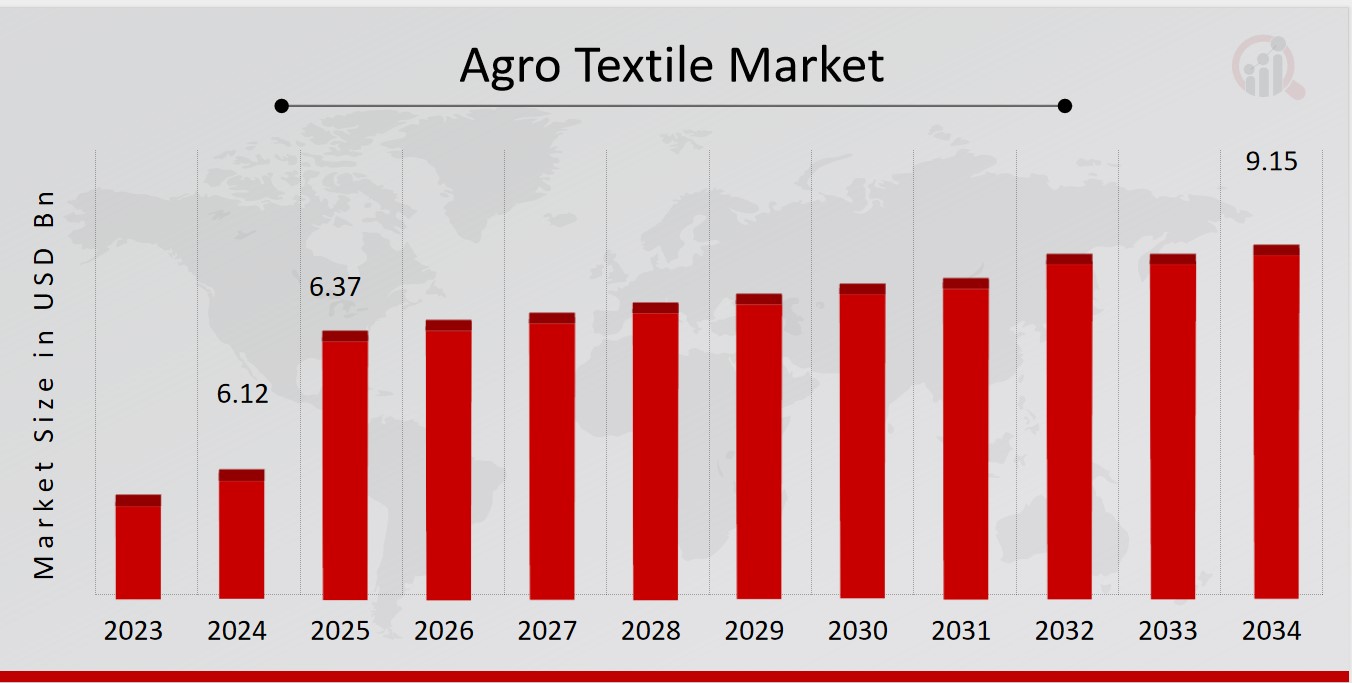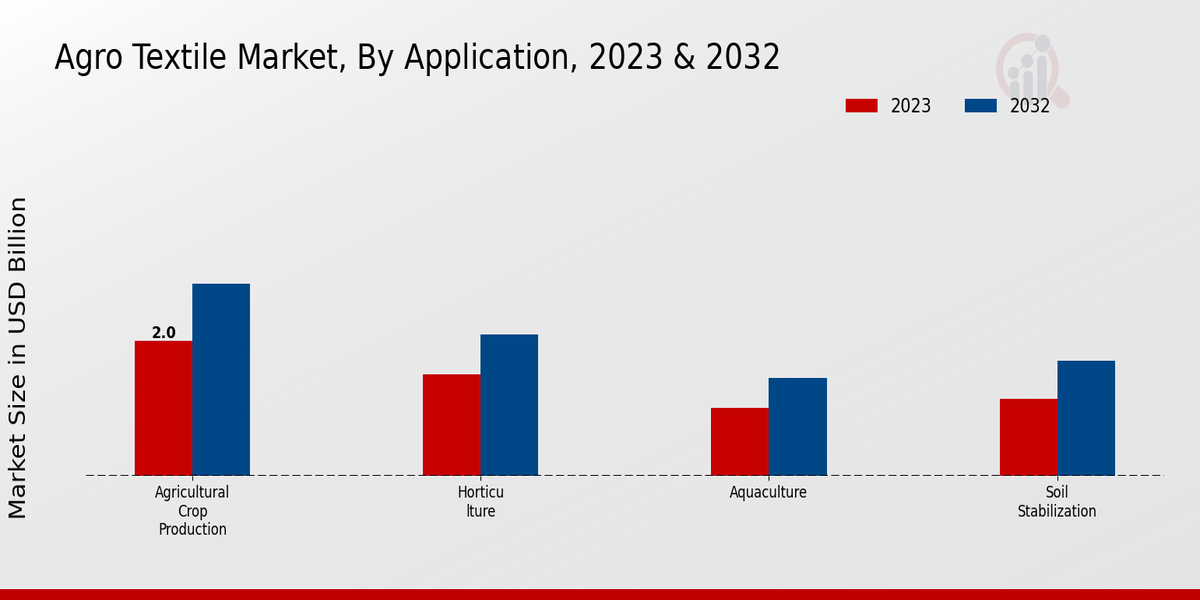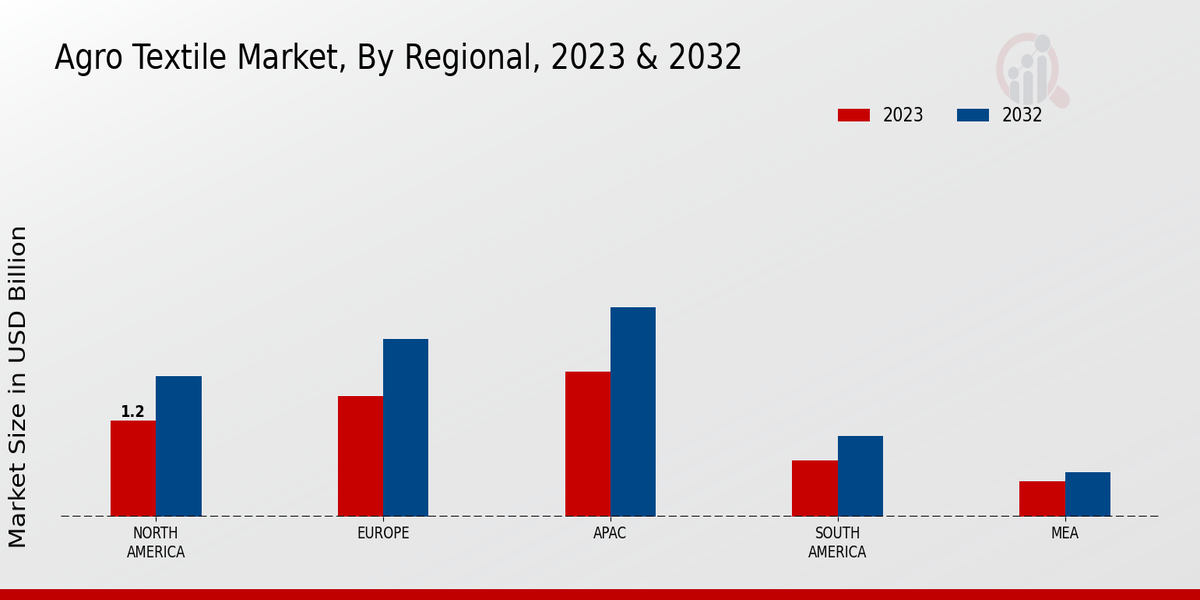Global Agro Textile Market Overview
The Agro Textile Market Size was estimated at 6.12 (USD Billion) in 2024. The Agro Textile Industry is expected to grow from 6.37 (USD Billion) in 2025 to 9.15 (USD Billion) by 2034. The Agro Textile Market CAGR (growth rate) is expected to be around 4.11% during the forecast period (2025 - 2034).
Key Agro Textile Market Trends Highlighted
The agro textile market is driven by the increasing need for agricultural productivity and sustainability. Factors such as rising food demand due to population growth and the necessity of protecting crops from pests and environmental stressors contribute to this growth. Additionally, innovations in agro textiles, like biodegradable and eco-friendly materials, cater to the rising awareness around environmental protection. These drivers highlight the importance of efficient agricultural practices, allowing farmers to enhance their output while minimizing their ecological footprint. There are numerous opportunities to be explored in this market.
The growing trend towards sustainable farming practices enables companies to develop advanced agro textile materials that meet the changing needs of agricultural producers. There is also significant potential in emerging markets, where improvements in agriculture are still in the early stages. By investing in new technologies and materials, companies can create products that improve crop yield and resilience. The demand for protective covers, erosion control fabrics, and other agro textiles encourages innovation and presents avenues for growth in product development and market penetration. Recent trends indicate a shift towards sustainable practices in agriculture, giving rise to increased adoption of agro textiles made from natural fibers.
The integration of smart technologies, such as moisture-retentive materials, is becoming more prevalent, enhancing the efficiency of agro textiles. Furthermore, there is a growing focus on research and development to create multifunctional products that not only protect crops but also improve soil quality. The market is also seeing investments in partnerships between agro textile manufacturers and agricultural organizations. These collaborations aim to promote awareness and educate farmers on the benefits of using agro textiles, leading to a more sustainable agricultural future.

Source: Primary Research, Secondary Research, MRFR Database and Analyst Review
Agro Textile Market Drivers
Increased Demand for Sustainable Agriculture Practices
The Agro Textile Market Industry is experiencing significant growth owing to the rising demand for sustainable agriculture practices. Farmers and agricultural businesses are increasingly focusing on environmentally friendly methods to ensure sustainable crop production. This has led to greater adoption of agro textiles that support organic farming and minimize the environmental footprint of agricultural activities. These textiles, which include products like shade nets, mulch mats, and crop covers, are designed to optimize resource use, enhance soil quality, and reduce dependency on chemical fertilizers and pesticides.
By integrating agro textiles into agricultural practices, farmers can achieve higher yields while aligning with sustainability goals. This trend is not just limited to developed countries; emerging economies are also witnessing a shift towards more sustainable practices, which drives the growth of the Agro Textile Market. As consumers demand greener products, agro textiles are becoming vital in meeting both agricultural and ecological needs.
Furthermore, advancements in textile technology are enhancing the functionality of agro textiles, enabling them to provide superior protection against pests, weather elements, and harmful UV rays. This, in turn, boosts their acceptance and utilization in the agricultural sector, leading to a marked increase in market size and value over the coming years.
Technological Advancements in Agro Textiles
Technological advancements in the manufacturing of agro textiles are significantly fueling the growth of the Agro Textile Market Industry. Innovations in material science and textile technology have led to the development of more efficient, durable, and multifunctional agro textiles. These technologies enhance the performance of agro textiles in terms of UV protection, water conservation, and pest resistance. Moreover, the introduction of smart agro textiles that integrate sensors and IoT capabilities enables farmers to monitor crop conditions in real time, thereby optimizing their agricultural practices.
As these technologies become more accessible, their adoption across various agricultural practices is expected to rise, driving substantial market growth.
Government Initiatives Supporting Agro Textile Usage
Government initiatives and policies supporting the usage of agro textiles are acting as a crucial driver for the Agro Textile Market Industry. Many governments worldwide are recognizing the importance of sustainable agricultural practices and are investing in programs that promote the adoption of agro textiles. Financial incentives, subsidies, and research funding aimed at developing new agro textile products are enhancing market growth. Such initiatives not only aim to improve crop yield and quality but also focus on environmental preservation, making agro textiles an integral part of future agricultural strategies.
Agro Textile Market Segment Insights
Agro Textile Market Application Insights
The Agro Textile Market is projected to reflect a growing trend in its Application segment, with significant contributions from various areas such as Agricultural Crop Production, Horticulture, Aquaculture, and Soil Stabilization. In 2023, the overall market valuation was reported at 5.64 USD Billion, indicating a robust interest and investment in agro textiles across these applications. Within this segment, Agricultural Crop Production emerges as the dominant player, boasting a valuation of 2.0 USD Billion in 2023, projected to increase to 2.85 USD Billion by 2032. This sub-segment holds majority importance in the market due to the increasing need for effective crop management solutions that enhance yield and promote sustainability practices in agriculture.
Horticulture also plays a significant role in the Agro Textile Market, with values reaching 1.5 USD Billion in 2023 and expected to grow to 2.1 USD Billion by 2032. The growing demand for ornamental plants and flowers contributes to its significance, as agro textiles aid in the protection of these plants while facilitating their growth under controlled conditions. Aquaculture captures interest as well, holding a market value of 1.0 USD Billion in 2023, with projections showing a rise to 1.45 USD Billion by 2032. This area has gained traction due to the increasing focus on sustainable fisheries and the need for enhanced fish farming practices, supported by the use of agro textiles for containment and environmental protection.
Soil Stabilization, although the smallest sub-segment at 1.14 USD Billion in 2023 with an anticipated increase to 1.7 USD Billion in 2032, remains a critical application due to its role in preventing soil erosion and promoting land conservation. This aspect is vital as agriculture increasingly faces challenges from climate change and land degradation. The overall Agro Textile Market segmentation showcases a strong trend towards innovation and sustainability, with each application addressing unique challenges in agriculture and environmental management, making it an essential industry for future growth. The market growth is driven by the need for better crop protection, enhanced agricultural productivity, and sustainable practices across diverse agricultural practices and applications, reflecting the evolving dynamics in the agro textile industry.

Source: Primary Research, Secondary Research, MRFR Database and Analyst Review
Agro Textile Market Material Insights
The Agro Textile Market, particularly in the Material segment, is seeing robust growth with a projected market value of 5.64 USD Billion in 2023, expected to reach 8.1 USD Billion by 2032. This growth is supported by a collective CAGR of 4.11 from 2024 to 2032. In terms of product types, Polypropylene and Polyethylene are essential materials due to their durability and versatility, making them favored choices for various agricultural applications. Cotton is valued for its biodegradability and comfort, while Jute is recognized for its eco-friendliness and cost-effectiveness.
Such materials are key drivers in the Agro Textile Market revenue, as they contribute to sustainable agricultural practices and improve crop protection. Market growth is further propelled by the increasing demand for biodegradable and environmentally friendly options, and while challenges exist, including the need for innovation in material technology, opportunities abound in sustainable agricultural solutions. The market segmentation highlights the importance of these materials in enhancing agricultural productivity and fostering eco-conscious farming practices.
Insights derived from Agro Textile Market data reveal these trends contributing to evolving agricultural standards.
Agro Textile Market Product Type Insights
The Agro Textile Market is projected to be valued at 5.64 USD Billion in 2023, highlighting a robust growth trajectory in the industry, influenced by various product types. Among these, shade nets are essential in protecting crops from excessive sunlight, thereby ensuring optimal growth conditions. Similarly, mulch mats significantly contribute to soil moisture retention and weed control, enhancing agricultural productivity. Geotextiles play a vital role in soil stabilization and erosion control in agricultural practices, making them a critical component of effective land management.
Crop protection covers provide necessary shielding against adverse weather conditions, pests, and diseases, allowing for a successful harvest. As the market evolves, the demand for these product types reflects broader trends such as increased agricultural modernization and sustainable farming practices. The Agro Textile Market segmentation further highlights opportunities for innovation and growth, with potential challenges including fluctuating raw material costs and the need for more awareness among farmers regarding the benefits of agro textiles.
The market growth is largely driven by the increasing need for improved crop yield and the sustainable management of agricultural resources, positioning the agro textile sector as a key player in the future of agriculture.
Agro Textile Market End Use Insights
The Agro Textile Market is poised to experience growth driven by various end-use applications. In 2023, the overall market is valued at 5.64 USD Billion, emphasizing the increasing adoption of agro textiles across different sectors. Within this segment, farmers play a crucial role, utilizing a variety of fabrics for crop protection, moisture retention, and soil health. Agricultural contractors also significantly contribute, as they leverage textile solutions for large-scale and efficient agricultural operations, often leading to enhanced productivity.
Gardeners represent another vital part of the market, utilizing agro textiles for purposes such as weed control and plant insulation. Overall, the diverse applications across these end uses highlight the importance of the Agro Textile Market industry, reflecting wider trends such as sustainability, efficiency, and the growing demand for innovative agricultural practices. The Agro Textile Market data indicates a significant opportunity for growth in these areas, supported by consumer trends favoring sustainable agriculture and garden management practices.
With continued innovations and focus on crop productivity, expected developments in market growth will further reinforce the pivotal roles of these end-users in the agro textile sector.
Agro Textile Market Regional Insights
The Agro Textile Market is being shaped by various regional dynamics, showcasing diverse valuation trends and market growth potential. In 2023, North America held a valuation of 1.2 USD Billion, which will rise to 1.75 USD Billion by 2032, marking it as a significant player in the market, driven by advanced agricultural practices and sustainable farming initiatives. Europe follows closely with a valuation starting at 1.5 USD Billion in 2023, growing to 2.2 USD Billion by 2032, reflecting a strong emphasis on regulatory frameworks supporting agro textiles.
The Asia-Pacific (APAC) region dominates with a more substantial valuation of 1.8 USD Billion in 2023, projected to reach 2.6 USD Billion in 2032, driven by a rapidly growing agricultural sector and increasing investment in agritech. South America has a moderate presence at 0.7 USD Billion in 2023, which climbs to 1.0 USD Billion by 2032, primarily influenced by expanding crop production. Meanwhile, the Middle East and Africa (MEA) account for the least share, valued at 0.44 USD Billion in 2023, growing to 0.55 USD Billion by 2032, facing challenges in agricultural infrastructure but holding potential due to emerging markets.
Overall, the regional segmentation of the Agro Textile Market highlights significant variances in growth opportunities, with APAC leading in market revenue, while North America and Europe showcase substantial growth driven by innovation and regulatory support.

Source: Primary Research, Secondary Research, MRFR Database and Analyst Review
Agro Textile Market Key Players and Competitive Insights
The Agro Textile Market is characterized by a diverse array of players engaged in the production and distribution of textiles specifically designed for agricultural applications. These players range from established multinational corporations to smaller niche companies, all competing on various fronts, such as innovation, quality, and sustainability. The competitive landscape is driven by increasing demand for agro textiles in areas like crop protection, soil erosion control, and agricultural packaging. Key trends influencing this market include advancements in materials technology, sustainability initiatives, and the growing emphasis on organic farming. The market dynamics are also shaped by the evolving regulatory environment and the need for companies to adapt their strategies in response to changing consumer preferences and environmental concerns.
Mahindra Agribusiness has marked a significant presence in the Agro Textile Market, leveraging its extensive network and deep understanding of customer needs. The company excels in creating a range of innovative agro textile products that address various agricultural challenges, such as crop protection and soil management. Mahindra Agribusiness has built a robust reputation for quality, sustainability, and performance, which enhances its competitive edge. The company's commitment to research and development ensures that it consistently introduces new and improved products that meet the demands of modern agriculture. Its strong brand presence and customer loyalty further bolster its position in the market, facilitating partnerships and collaborations that enhance its market share and operational efficiency.
BASF has established itself as a leader in the Agro Textile Market through a combination of innovation and commitment to sustainability. The company specializes in developing agro textiles that not only improve agricultural productivity but also contribute positively to environmental conservation efforts. BASF's extensive research initiatives focus on creating new materials and technologies that enhance the performance and durability of agro textiles, further driving market growth. The company's ability to integrate broad industry knowledge with cutting-edge technology allows it to provide comprehensive solutions tailored to diverse agricultural needs. In addition, BASF's reach and well-established distribution networks enable it to effectively penetrate various markets, making it a formidable competitor in the agro textile sector.
Key Companies in the Agro Textile Market Include
- Mahindra Agribusiness
- BASF
- Freudenberg Group
- Berry
- MCC Polymers
- Invista
- TenCate Geosynthetics
- Mitsubishi Chemical Corporation
- NatureWorks
- Nonwoven Innovations
- The Dow Chemical Company
- Agrichem Microbial
- DuPont
- Tencate
- R. Grace and Co.
Agro Textile Market Industry Developments
Recent developments in the Agro Textile Market show a significant evolution in market dynamics, driven by sustainability trends and technological innovations. Companies like Mahindra Agribusiness and BASF are focusing on developing eco-friendly textile solutions that cater to growing environmental concerns. Freudenberg Group and Berry are advancing their product lines with innovative materials that enhance durability and functionality for agricultural applications. The market is also witnessing strengthening collaborations, with recent mergers and acquisitions notable among key players. MCC Polymers acquired specific divisions from the Dow Chemical Company, enhancing their portfolio in agro textiles. Companies like DuPont and Mitsubishi Chemical Corporation are investing in research and development to address the increasing demands for biodegradable and sustainable textiles. The current market valuation sees noticeable growth, impacting competitive positioning among organizations such as TenCate Geosynthetics and W. R. Grace and Co. with increased investments in sustainable technologies. Meanwhile, NatureWorks and Nonwoven Innovations continue to pioneer developments in bio-based textile solutions, positioning themselves favorably in a market pushed towards sustainability and cutting-edge innovations. Overall, these trends indicate an evolving landscape focused on environmentally responsible materials and competitive growth strategies.
Agro Textile Market Segmentation Insights
Agro Textile Market Application Outlook
- Agricultural Crop Production
- Horticulture
- Aquaculture
- Soil Stabilization
Agro Textile Market Material Outlook
- Polypropylene
- Polyethylene
- Cotton
- Jute
Agro Textile Market Product Type Outlook
- Shade Nets
- Mulch Mats
- Geotextiles
- Crop Protection Covers
Agro Textile Market End Use Outlook
- Farmers
- Agricultural Contractors
- Gardeners
Agro Textile Market Regional Outlook
- North America
- Europe
- South America
- Asia Pacific
- Middle East and Africa
|
Report Attribute/Metric
|
Details
|
|
Market Size 2024
|
6.12 (USD Billion)
|
|
Market Size 2025
|
6.37 (USD Billion)
|
|
Market Size 2034
|
9.15 (USD Billion)
|
|
Compound Annual Growth Rate (CAGR)
|
4.11% (2025 - 2034)
|
|
Report Coverage
|
Revenue Forecast, Competitive Landscape, Growth Factors, and Trends
|
|
Base Year
|
2024
|
|
Market Forecast Period
|
2025 - 2034
|
|
Historical Data
|
2020 - 2024
|
|
Market Forecast Units
|
USD Billion
|
|
Key Companies Profiled
|
Mahindra Agribusiness, BASF, Freudenberg Group, Berry , MCC Polymers, Invista, TenCate Geosynthetics, Mitsubishi Chemical Corporation, NatureWorks, Nonwoven Innovations, The Dow Chemical Company, Agrichem Microbial, DuPont, Tencate, W. R. Grace and Co.
|
|
Segments Covered
|
Application, Material, Product Type, End Use, Regional
|
|
Key Market Opportunities
|
Sustainable materials demand growth, Increasing agro-tech adoption, Expanding organic farming practices, Rising awareness of soil health, Innovative crop protection solutions.
|
|
Key Market Dynamics
|
sustainability trends, advanced agricultural practices, demand for crop protection, innovation in materials, increasing consumer awareness
|
|
Countries Covered
|
North America, Europe, APAC, South America, MEA
|
Frequently Asked Questions (FAQ) :
The Agro Textile Market is anticipated to be valued at approximately 6.37 USD Billion in 2025.
By 2034, the Agro Textile Market is projected to reach a value of 9.15 USD Billion.
The Agro Textile Market is expected to grow at a CAGR of 4.11% from 2025 to 2034.
The Agricultural Crop Production segment is expected to grow to approximately 2.85 USD Billion by 2032.
The Horticulture application segment is expected to be valued at around 1.9 USD Billion in 2024.
North America is projected to dominate the market, reaching an estimated value of 1.75 USD Billion by 2032.
The South America region is anticipated to reach a market size of approximately 1.0 USD Billion by 2032.
Key players in the market include Mahindra Agribusiness, BASF, and Freudenberg Group, among others.
The market is expected to benefit from advancements in agricultural technologies and increasing demand for sustainable practices.
Challenges include fluctuations in raw material prices and regulatory hurdles impacting production processes.

















